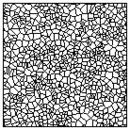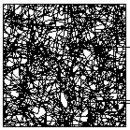Polymer Networks
 Fibrous and cellular materials are ubiquitious in
nature. Prominent examples are found in biology such as bone,
wood and the cytoskeleton of cells. The elastic properties of
these biomaterials result from a subtle interplay between the
architecture of the network and the elastic properties of its
building blocks.
Fibrous and cellular materials are ubiquitious in
nature. Prominent examples are found in biology such as bone,
wood and the cytoskeleton of cells. The elastic properties of
these biomaterials result from a subtle interplay between the
architecture of the network and the elastic properties of its
building blocks.
 In these networks highly non-affine deformations as well as
inhomogeneous distribution of stresses have been found. Few is
known, however, about the actual nature of the deformations
present. The expression "non-affine" is exclusively used to
signal the absence of affine deformations that are used for
example in the theory of rubber elasticity. This work tries
to fill this gap by characterizing in detail the non-affine
deformation field present in fibrous networks. By relating
non-affinity to the low-energy excitations we can, starting
from a microscopic picture, calculate the macroscopic elastic
moduli both in a scaling theory and a self-consistent effective
medium theory.
In these networks highly non-affine deformations as well as
inhomogeneous distribution of stresses have been found. Few is
known, however, about the actual nature of the deformations
present. The expression "non-affine" is exclusively used to
signal the absence of affine deformations that are used for
example in the theory of rubber elasticity. This work tries
to fill this gap by characterizing in detail the non-affine
deformation field present in fibrous networks. By relating
non-affinity to the low-energy excitations we can, starting
from a microscopic picture, calculate the macroscopic elastic
moduli both in a scaling theory and a self-consistent effective
medium theory.
In a second study [2] we highlight the very special properties
of networks of thermally fluctuating stiff polymers. As
compared to their purely mechanical counterparts, it is shown
that these thermal networks have a qualitatively different
elastic response. By accounting for the entropic origin of
the single-polymer elasticity, the networks acquire a strong
susceptibility to polydispersity and structural randomness that
is completely absent in athermal models.
In extensive numerical studies we systematically vary the
architecture of the networks and identify a wealth of phenomena
that clearly show the strong dependence of the emergent
macroscopic moduli on the underlying mesoscopic network
structure. In particular, we highlight the importance of the
full polymer length that to a large extent controls the elastic
response of the network, surprisingly, even in parameter regions
where it does not enter the macroscopic moduli explicitly. We
provide theoretical scaling arguments to relate the observed
macroscopic elasticity to the physical mechanisms on the
microscopic and the mesoscopic scale.
Literature:
-
C. Heussinger and
E. Frey,
Floppy Modes and Nonaffine Deformations in Random Fiber Networks,
Phys. Rev. Lett. 97, 105501 (2006) -
C. Heussinger and
E. Frey,
Stiff Polymers, Foams and Fiber Networks,
Phys. Rev. Lett. 96, 017802 (2006) [arXiv:cond-mat/0503359] -
C. Heussinger and
E. Frey,
The Role of Architecture in the Elastic Response of Semiflexible Polymer and Fiber Networks,
[arXiv:cond-mat/0512557]

